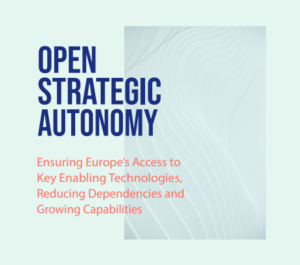 This paper presents a view on how a strategic policy approach to Open Technologies can support the reduction of dependencies and increasing capabilities found wanting in Europe.
This paper presents a view on how a strategic policy approach to Open Technologies can support the reduction of dependencies and increasing capabilities found wanting in Europe.
The report was presented during OFE’s event on 23 March: Open Strategic Autonomy: Public and Private Sector Perspectives.
What are the root causes that present a challenge to Europe achieving digital sovereignty? What is a sovereign decision when we talk about buying digital solutions? How to tackle the two dependency dimensions that Europe needs to address: technology dependency and supplier dependency?
Without access to the global manpower, IP and technology capacity it is unrealistic for Europe to attempt to develop competing proprietary solutions and expect to reduce supplier dependencies. That’s why open technologies play a significant role here, as they are based on a time-tested legal framework that ensures collaboration and open access.
While Open Source Software alone is already contributing between €65bn and €95bn to Europe’s GDP, the potential of Open Technologies is still not taken full advantage of. Many of the key Open Tech projects are being steered without European involvement.
Open Source is the Digital Public Infrastructure our society runs on, like pedestrians and vehicles run on publicly funded roads and bridges. The difference is that in the digital open technologies world everyone can contribute to creating this infrastructure. In many ways Europe’s cultural and organisational model (the EU’s “united in diversity”) is a very good match for the cooperative modus operandi of open technologies and can inspire the much needed culture change to ‘open’.
So, how can Europe support Open Source to reap the benefits it brings?
• Support creation of OSPOs in both public and private sector,
• Affirm open source definition,
• Redevelop only when needed and increase participation in global open source projects,
• Prioritise procuring open technologies strategically over funding research,
• Build on and use open standards,
• Set uniform, goal-oriented requirements for technology providers.